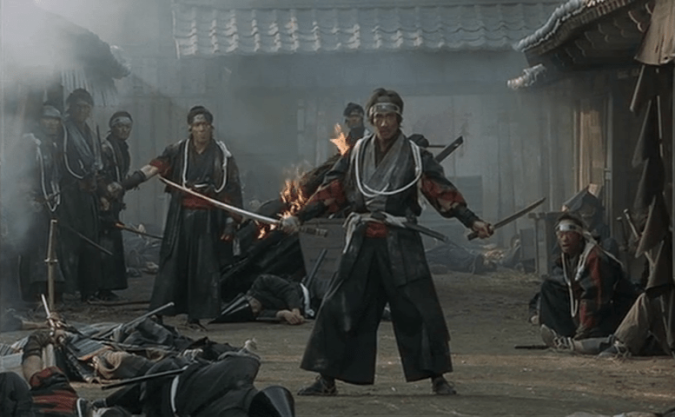 When the Last Sword is Drawn takes us back to the Shinsengumi, but in a far more romanticized and sentimentalized form than we have usually seen. Told in flashbacks, it follows Yoshimura, a fictional character, seen first when he joined the company’s ranks, then in later flashbacks filling in his life before he came to Kyoto.
When the Last Sword is Drawn takes us back to the Shinsengumi, but in a far more romanticized and sentimentalized form than we have usually seen. Told in flashbacks, it follows Yoshimura, a fictional character, seen first when he joined the company’s ranks, then in later flashbacks filling in his life before he came to Kyoto.
From the first moment, Yoshimura (Kiichi Nakai) is seen as a superb swordsman, but Saito (Koichi Sato), one of the group’s leaders, decides he is a country bumpkin who needs to be killed, just because. Unable to do so in a one on one fight in the rain, Saito observes and watches for his chance again. Yet, when the group begins to fall apart as the Shogunate faces open rebellion, Yoshimura opts to stay, even though he knows it is a lost cause. Saito last sees him charging single-handedly into the guns at the Battle of Toba-Fushimi.
Since Yoshimura first appears in an audition duel for the Shinsengumi, the movie immediately suggests Gohatto, but told with the focus on Tashiro the ronin. However, this introduction occurs before the Ikedaya Inn raid and Yoshimura though a poor ronin is quite a different character. He quickly earns a mercenary reputation, always asking for rewards beyond his regular pay for his work. He even demands a bribe to keep his mouth shut after Saito murders another clan member who had shown cowardice during the Ikedaya Inn raid. But unknown to the rest of the group, he sends all his money back to his family. From the small Nanbu clan of Morioka in the northeast, Yoshimura deserted his clan because the years of famine in the area had left his family starving and he saw this as the only way to earn money.
Despite coming to the Shinsengumi solely to get money, Yoshimura opts to stay loyal because he can not let himself desert a second lord. Over the years, Saito develops a grudging respect and even friendship for him, at one point using Yoshimura as the go-between when Saito goes underground to spy on Shinsengumi who have changed sides, and only fails to follow the charge with Yoshimura because he has been shot in the leg and cannot stand up. Had the movie ended with Yoshimura’s solo charge, it would have been a fairly traditional but quite good jidai-geki.
Unfortunately, the movie doesn’t end there. The movie is framed by Saito’s visit to a doctor with his sick grandchild, and the flashbacks are spurred by a photo of Yoshimura found there. It is the doctor who fills in the family information, for he was the son of the Nanbu lord, a student of Yoshimura, and a friend of Yoshimura’s son. This not only takes us back to the tearful exit of Yoshimura from the clan, but also adds his sudden reappearance, heavily wounded, at the home of the Nanbu lord in Edo. The lord can not protect him without bringing ruin on all the clan, so he leaves a sword for Yoshimura to use to commit seppuku.

Yoshimura remembering before his death
He eventually does, but not before many memories of his home and family and expressions of his love for them both in a scene as drawn-out as the death of Camille. Nakai handles the long scene as well as anyone could be expected to do, but it is nevertheless a loooong scene. And if that is not enough, we continue with the doctor’s explanation of his own tearful farewells to Yoshimura’s son who runs off to die at Hakodate, the end of the family clan, and the explanation of the photograph (he married Yoshimura’s daughter).
And so director Yojiro Takita manages to turn a good action jidai-geki into a tear-jerker. Add in Joe Hisaishi’s music, excellent of its type but the type is Chuji Kinoshita’s scores in the early fifties, and three hankies won’t be enough; maybe a whole box of Kleenex was needed by the original audience before the nearly 2½ hours are over. Perhaps it will be no surprise that it is based on a story by Jiro Asada, who wrote the original for Railroad Man, which also had the same tendency to tell us everything again and again and to milk every possible tear from its ending.
Rather unusually, the movie split Japanese critics, with the Japan Academy giving it Best Film, with Nakai Best Actor and Sato Best Supporting Actor, while Kinema Junpo placed it only 23rd. If you’re a chanbara fan, the sword scenes are generally good, with the Ikedaya Inn raid bloody and varied and the personal duel in the rain well staged. If you are unfamiliar with the history, the flashbacks are all narrated by Saito or the doctor, so there is never any difficulty following who is on whose side at any particular moment, unlike the confusion we have seen in so many earlier Shinsengumi movies. But if you are a fan of the traditional chanbara, you might want to stop after Yoshimura disappears into the rifle smoke. On the other hand, if you like a good cry, this is the sword-play movie for you.



There is a television mini-series version starring Ken Watanabe as Yoshimura. It opens during the battle between shogunate supporters and imperial forces with Yoshimura running toward the gunfire (as in the movie) then cuts to a flashback of his life before leaving his clan.
LikeLike
Pingback: Twilight Samurai / Tasogare Seibei (2002) | Japanonfilm
Pingback: Samurai I Loved / Chorus of the Cicadas / Semishigeru (2006) | Japanonfilm